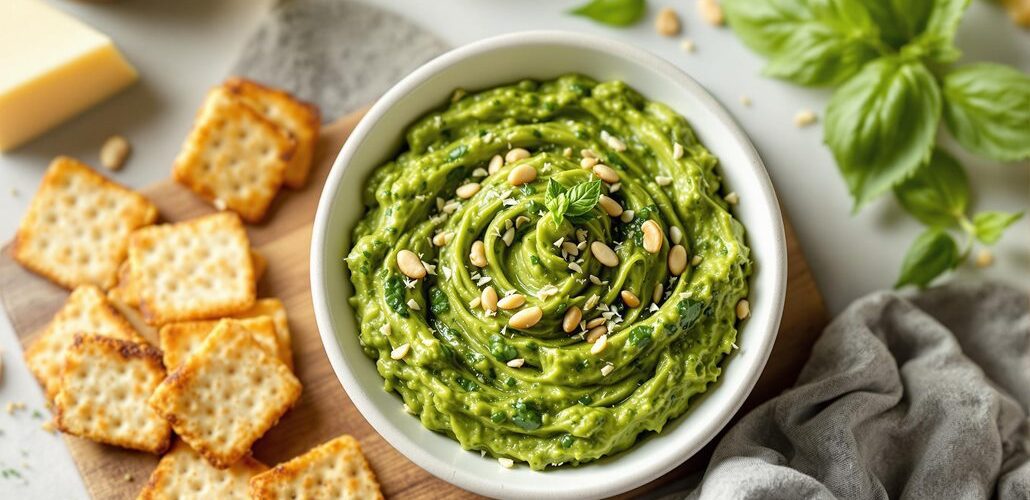
Pesto is keto-friendly due to its low carbohydrate content, roughly 2.1 net grams per ¼ cup serving, making it ideal for low-carb diets. It features nutrient-rich ingredients such as basil, which provides vitamins and antioxidants, and olive oil, known for its heart-healthy monounsaturated fats. Parmesan cheese adds protein and calcium with minimal carbs. Homemade pesto is preferable, allowing customization to minimize preservatives and sugars present in some store-bought versions. Its high healthy fat content supports ketosis while enhancing meal flavors. Exploring pesto's versatility can reveal its advantages in maintaining a ketogenic lifestyle and optimizing nutritional intake.
Key Takeaways
- Traditional pesto is keto-friendly, with approximately 2.1 net grams of carbs per ¼ cup serving.
- Homemade pesto typically maintains less than 2 grams of net carbs per serving, ideal for keto diets.
- Store-bought pesto may contain added sugars and higher carbs, so label scrutiny is essential.
- Pesto pairs well with low-carb foods like zucchini noodles and grilled meats for keto compliance.
- Customizing homemade pesto with low-carb nuts can further reduce carbohydrate content.
Understanding Pesto
At its core, pesto is a quintessential Italian sauce that embodies simplicity and rich flavor through its traditional ingredients: fresh basil, parmesan cheese, garlic, pine nuts, and olive oil.
This classic combination not only delivers a burst of herbaceous taste but also aligns with the principles of a low-carb diet, making pesto a suitable choice for those following a Keto lifestyle. With approximately 2.1 net grams of carbohydrates per ¼ cup serving, pesto fits well into a regimen that prioritizes low carbohydrate intake.
The main ingredients of pesto, particularly Parmesan cheese and olive oil, contribute to its nutrient density. Parmesan cheese provides a valuable source of calcium and protein, while olive oil delivers monounsaturated fats, known for their heart health benefits.
These components make pesto an excellent addition to a diet focused on nutrient-rich foods. Additionally, homemade pesto offers the advantage of customization, allowing individuals to control carbohydrate content by adjusting ingredients, thereby minimizing preservatives and added sugars often present in store-bought versions.
Nutritional Value of Pesto
Pesto's nutritional value aligns well with ketogenic dietary needs, primarily due to its low carbohydrate content and high healthy fat profile. A standard serving contains only 2.1g of net carbs, with key ingredients like basil and olive oil contributing to this low-carb composition.
Additionally, homemade versions of pesto typically avoid added sugars and high-carb fillers, much like how keto-friendly sweeteners such as stevia and erythritol are chosen for their low glycemic index and minimal impact on blood sugar levels. This further enhances its suitability for low-carb and ketogenic diets.
Key Ingredients Analysis
With its blend of aromatic basil, rich olive oil, and savory parmesan cheese, pesto offers a nutritional profile that aligns well with keto dietary principles. Central to pesto's composition, basil provides essential vitamins and antioxidants, enhancing the dish's health benefits without adding significant carbohydrates.
Pine nuts, though containing approximately 3-4 grams of carbohydrates per ounce, contribute healthy fats that are essential for those following keto diets. Their inclusion in moderate amounts guarantees pesto remains low in carbs.
Olive oil, a staple in pesto, is celebrated for its heart-healthy monounsaturated fats, which support overall well-being while maintaining the sauce's low carbohydrate content. Parmesan cheese further complements this nutritional profile by being low in carbs and rich in fat and protein, adding a creamy texture and depth of flavor without compromising keto compliance. Additionally, parmesan is virtually lactose-free, making it suitable for those with lactose sensitivities.
The adaptability of homemade pesto allows for further customization. By adjusting the types and quantities of nuts and cheese, one can create a flavorful sauce that adheres even more closely to keto guidelines, optimizing the nutritional profile for individual dietary needs.
Carb Content Details
Delving into the carb content of pesto reveals its compatibility with low-carb and keto diets, largely due to its minimal carbohydrate presence and high healthy fat content.
Traditional pesto contains approximately 2.1 net grams of carbohydrates per 1/4 cup (61g) serving, which is favorable for those adhering to a low-carb regimen. A standard 50g serving of classic basil pesto has about 1.85 grams of carbs, aligning well with keto principles that emphasize reduced carbohydrate intake.
The primary pesto ingredients, such as basil, pine nuts, and olive oil, contribute to its low-carb profile. These ingredients not only guarantee that pesto contains minimal net carbs but also provide essential fatty acids, making it an excellent addition to keto-friendly dishes.
Homemade pesto, depending on ingredient choices, typically has less than 2 grams of net carbs per 1/4 cup serving, allowing for better control over carb content.
However, it is vital to note that some store-bought pestos can contain over 6.5 grams of carbohydrates per serving. Consequently, checking labels is necessary to verify that the pesto aligns with dietary goals.
Keto Pesto Recipes
Incorporating pesto into a ketogenic diet can be both flavorful and nutritionally advantageous, as it aligns with the high-fat, low-carb principles of keto eating.
Keto pesto, made with fresh basil, toasted pine nuts, and simple ingredients like garlic and parmesan, offers a delicious keto option for meal planning. This versatile sauce can be integrated into various low-carb recipes, enhancing both taste and nutritional value.
For instance, Keto Pesto Pizza utilizes almond flour for the crust and low-carb cheese, ensuring that the dish remains in line with ketogenic standards while delivering robust flavors. Additionally, this complements the nutrient-rich benefits of incorporating seafood, like shrimp or salmon, into the meal.
Meanwhile, Keto Pesto Chicken combines succulent chicken with homemade pesto, providing a high-fat, low-carb meal that satisfies keto dietary needs.
Keto Pesto Pasta offers a creative twist by incorporating zucchini noodles, allowing pasta lovers to enjoy a classic dish without compromising their diet.
Additionally, Keto Pesto Salad and Keto Pesto Dip provide invigorating and healthy options. The salad, tossed with fresh vegetables and pesto, and the dip, served alongside low-carb veggies, present excellent choices for those seeking nutritious, low-carb snacks.
These pesto recipes are ideal for anyone committed to maintaining a ketogenic lifestyle.
Store-Bought vs. Homemade
When considering the nutritional implications of pesto in a ketogenic diet, the choice between store-bought and homemade varieties becomes significant.
Store-bought pesto often includes added sugars and high-carb ingredients, potentially compromising the core low-carb principles of a ketogenic diet. It is vital for consumers to scrutinize nutritional labels, as some commercial pesto sauces can contain up to 6.5 grams of carbohydrates per serving.
To guarantee adherence to a ketogenic lifestyle, electrolyte balance is also vital, as it can prevent symptoms like headaches and fatigue during adaptation.
Conversely, homemade pesto offers a more controlled approach, allowing for adjustments that guarantee low-carb compliance and the avoidance of preservatives or unwanted additives. Homemade pesto, with about 1.85 grams of carbohydrates per serving, emerges as a preferred option for those adhering to a ketogenic lifestyle.
Its customizable nature allows for the incorporation of low-carb nuts, such as pecans instead of traditional pine nuts, further decreasing its carbohydrate content without sacrificing flavor. This versatility makes homemade pesto an ideal choice for dishes like pesto chicken, where maintaining a low-carb profile is essential.
Pesto on a Keto Diet
Incorporating pesto into a ketogenic diet requires a thorough analysis of its carbohydrate content, with traditional pesto offering approximately 2.1 net grams of carbs per ¼ cup, fitting well within the keto guidelines that range from 20-50 grams per day.
It's essential to take into account the ingredient list and opt for versions with minimal added sugars and shorter ingredient lists to support keto goals.
Homemade pesto can be particularly advantageous, as it allows for customization, such as replacing pine nuts with pecans to further reduce carbohydrate content to about 1.1 grams per 50g serving.
Careful pairing with low-carb options like zucchini noodles or grilled chicken is vital to maintain ketosis and enhance the nutritional benefits of this flavorful sauce.
Carb Content Analysis
Pesto's nutritional profile makes it a potential ally for those adhering to a ketogenic diet, primarily due to its low carbohydrate content. Analyzing the carb content of pesto reveals its suitability for low-carb diets.
Pesto Keto-Friendly options often feature low carbohydrates per serving, especially when made with ingredients like basil and olive oil. According to Nutrition Facts, traditional pesto contains approximately 2.1 net grams of carbohydrates per ¼ cup serving, making Pesto an excellent addition to keto meal plans. The carb intake can be further managed by opting for homemade pesto, where specific recipes with toasted pine nuts and cheese can reduce carb counts to as low as 1.1 grams per 50g serving.
Here is a breakdown of pesto's carb content:
- Traditional Pesto: Typically offers around 1.85g of carbohydrates per 50g serving, aligning with keto dietary restrictions.
- Store-Bought Variations: Some can contain over 6.5g of carbohydrates per serving, highlighting the need for careful label examination for keto compliance.
- Homemade Pesto: Can be customized to achieve lower carbohydrate counts, offering as little as 1.1g of carbs per 50g serving by adjusting the types of nuts and cheese used.
Homemade vs. Store-Bought
Choosing between homemade and store-bought pesto on a ketogenic diet involves careful consideration of nutritional content and ingredient quality.
Homemade pesto sauce offers a distinct advantage by allowing individuals to make precise adjustments in ingredient selection and carb content. Typically containing about 1 gram of carbohydrates per tablespoon, homemade pesto is a keto-friendly option that can be further optimized by incorporating low-carb nuts like pecans instead of traditional pine nuts. This customization not only reduces carb intake but also guarantees the use of natural ingredients such as fresh basil, olive oil, and garlic, which contribute to a nutrient-dense profile.
Store-bought pesto, on the other hand, often includes added sugars, preservatives, and higher-carb components that can challenge keto compliance. Reading labels becomes essential, as some commercial options may contain as much as 6.5 grams of carbohydrates per serving.
While both homemade and store-bought versions can fit within a low-carb framework, homemade pesto provides the flexibility to align with personal dietary goals. By preparing pesto at home, which takes about 5 to 15 minutes, one can avoid the pitfalls of processed ingredients, guaranteeing a fresher, healthier pesto sauce that adheres to ketogenic principles.
Pairing Pesto Wisely
Integrating pesto into a keto diet requires strategic selection of complementary foods to maintain low carbohydrate intake while enhancing flavor. Basil pesto, traditionally containing approximately 2.1 net grams of carbohydrates per ¼ cup serving size, serves as a flavorful addition to various keto-friendly meals.
To maintain the low-carb integrity of the diet, it is advisable to pair pesto with foods that align with keto principles.
- Low-Carb Foods: Incorporate keto pesto with low-carb options such as zucchini noodles or grilled meats. These pairings provide a satisfying meal experience without exceeding carbohydrate limits.
- Avoid High-Carb Ingredients: Steering clear of traditional pasta or bread is essential. Such high-carb ingredients can neutralize the benefits of using keto pesto, undermining its effectiveness in a low-carb diet.
- Homemade Pesto: Opt for homemade pesto to guarantee ingredient quality and alignment with keto standards. This approach eliminates the risk of added sugars found in some store-bought varieties, offering better control over nutritional content.
Using pesto as a dip for low-carb vegetables or a topping for salads can further enhance flavor while preserving the meal's low carbohydrate profile.
Tips for Keto Compliance
For those adhering to a keto diet, guaranteeing compliance begins with understanding ingredient composition, particularly when it comes to sauces like pesto. Crafting homemade pesto offers control over its nutritional content, making certain it aligns with keto principles. Utilizing a food processor, blend high-fat, low-carb ingredients such as extra virgin olive oil, pine nuts, and parmesan cheese. Incorporating lemon juice not only enhances flavor but also adds a touch of Vitamin C, an essential nutrient.
Adding avocado can increase the healthy fats content, further supporting ketosis. This approach minimizes the grams of carbs per serving, vital for those targeting weight loss on a keto regimen.
When considering store-bought pesto, scrutinize nutrition labels diligently. Some brands exceed 6.5 grams of carbs per serving, potentially hindering keto goals. Choosing high-quality extra virgin olive oil-based pesto guarantees better control over saturated fat intake, aligning with a health-oriented lifestyle.
Pair pesto with low-carb foods, such as zucchini noodles or grilled chicken, to maintain keto benefits while diversifying meals.
For a revitalizing twist, consider a salad recipe incorporating pesto as a dressing. This not only enriches the dish with healthy fats but also keeps carb intake in check, supporting sustained ketosis and promoting overall health.
Frequently Asked Questions
How Many Carbs Are in Pesto?
Pesto's carbohydrate content varies; traditional recipes contain approximately 2.1 net grams per ¼ cup. Nutritional benefits can be maximized by choosing homemade pesto or checking labels on store-bought options. Ingredient modifications offer diverse pesto variations for health-focused diets.
Is Pine Nut Good for Keto?
Pine nuts are an excellent keto snack due to their low carb content and high healthy fats, enhancing nutrient density in meal prep. They offer significant benefits, serving as a versatile food substitution in various keto recipes.
Is Hummus Allowed in Keto?
Hummus, traditionally made with chickpeas, is generally not keto-friendly. However, hummus alternatives using chickpea substitutes like cauliflower or avocado provide low carb dips. These keto-friendly spreads offer healthy fats, suitable for vegan keto and meal prepping.
Can I Have Garlic in Keto?
Garlic is keto-friendly due to its low carbohydrate content and health benefits. It enhances flavor and supports heart health. Explore garlic varieties, recipes, and supplements for diverse uses, while proper storage maintains its nutritional integrity.
Conclusion
Pesto is generally considered keto-friendly due to its low carbohydrate content and high levels of healthy fats from ingredients such as olive oil, nuts, and cheese. When integrating pesto into a ketogenic diet, attention should be paid to portion sizes and the selection of ingredients to guarantee compliance with macronutrient goals. Homemade pesto offers greater control over ingredients compared to store-bought options, which may contain added sugars or non-keto-friendly oils, thereby supporting a more nutrient-focused dietary approach.









No Comments